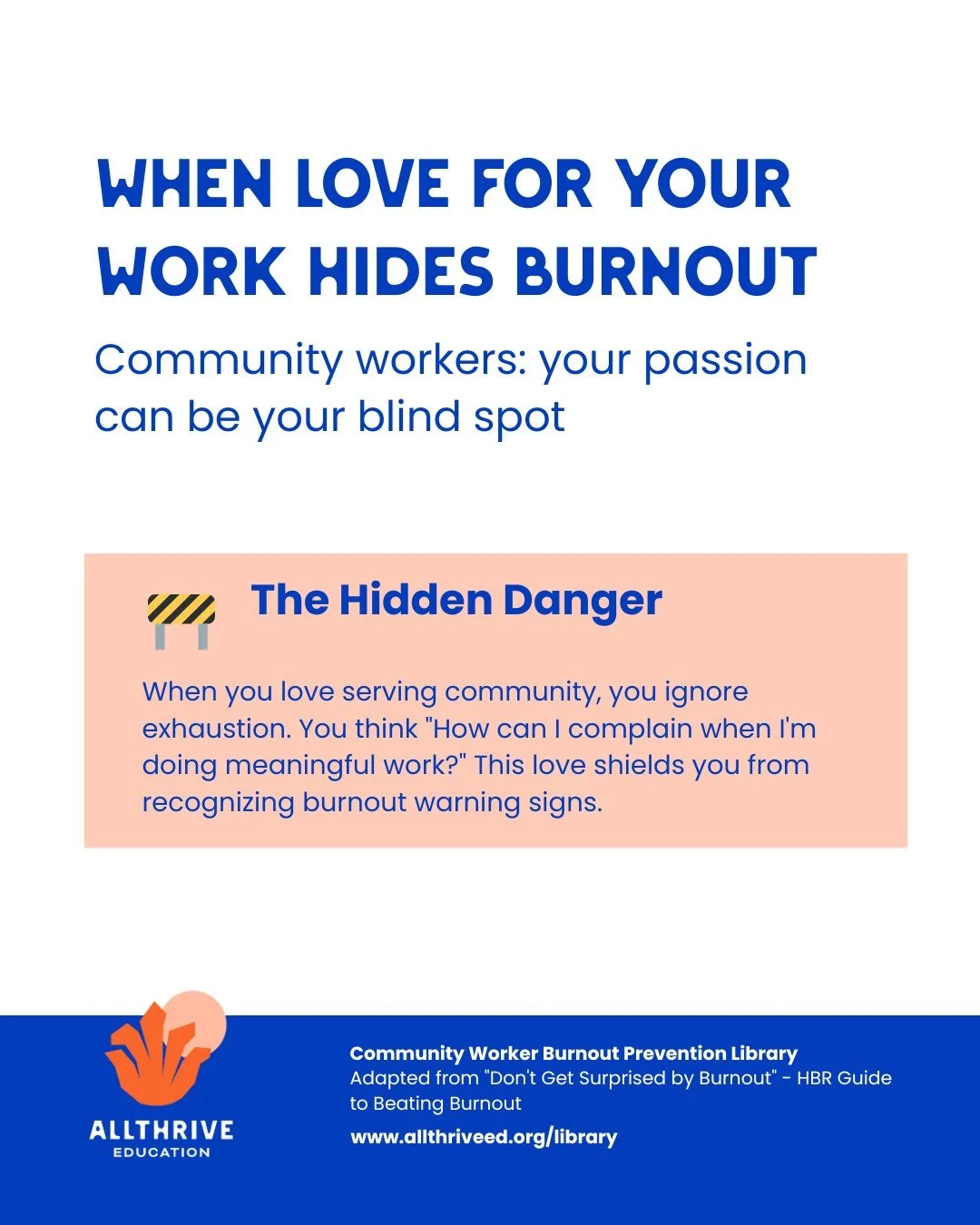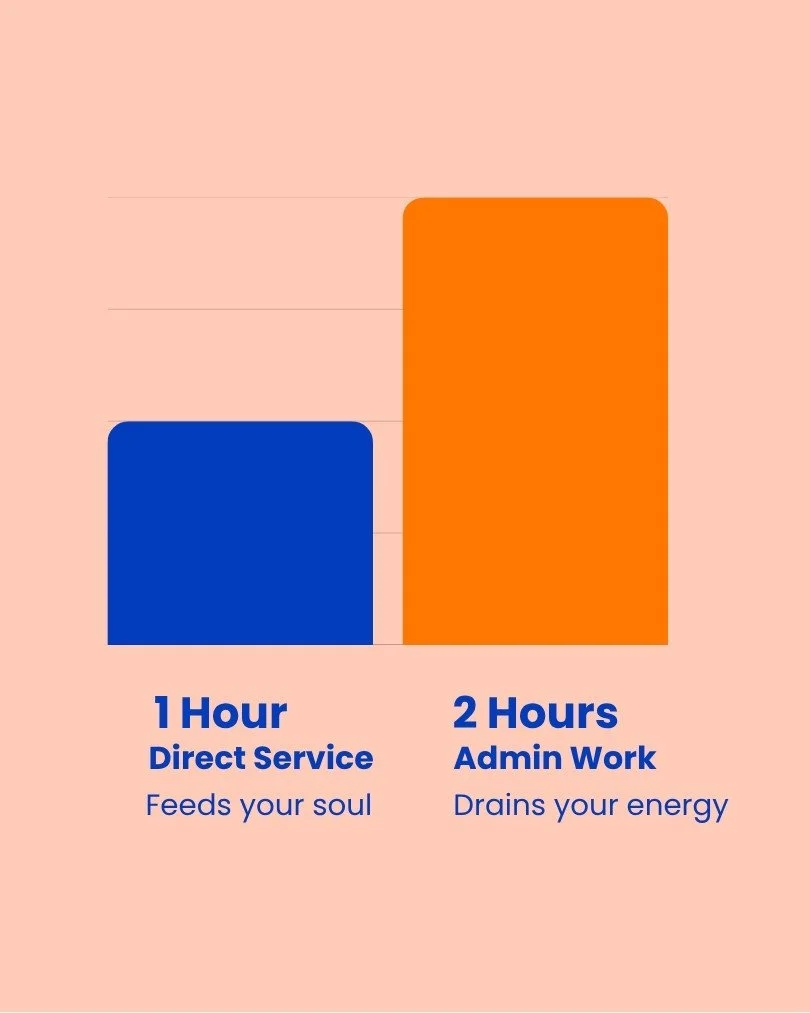When Love for Your Work Hides Burnout Warning Signs
A Community Worker's Guide to Recognizing Burnout Despite Loving What You Do
Learning Objectives
By the end of this resource, you will be able to:
Recognize how love for community work can mask burnout symptoms
Identify your personal "2-to-1 ratio" and its impact on your well-being
Apply three practical strategies to protect your energy while maintaining your passion
Navigate the guilt that comes with needing rest when your community needs you
Quick Self-Assessment
Rate yourself 1-5 (5 = always, 1 = never):
How often do you ignore exhaustion because you love your mission? ___
How often do you feel guilty for being tired by work you chose? ___
How often do you push through warning signs your body sends? ___
If you scored 12+ total, this resource is especially for you.
The Hidden Danger: When Love Becomes a Blind Spot
You got into community work because you genuinely care. You see the best in people and believe change is possible. You feel blessed to serve your community and get paid for meaningful work. This love is your superpower – and your vulnerability.
When you love what you do, your passion acts like a shield that blocks warning signs of burnout. You think: "How can I complain when Maria finally got housing?" or "At least I'm not in a corporate job just chasing profit."
The problem: Your love for the mission can make you ignore what your body and mind are desperately trying to tell you.
The Community Worker Reality: Your Personal 2-to-1 Ratio
Here's what most community workers experience but rarely discuss:
For every 1 hour of direct community service (the part that feeds your soul):
2 hours of everything else: grant writing, documentation, reporting, meetings about meetings, compliance paperwork
That one hour of meaningful connection – seeing someone's breakthrough, facilitating healing, building community power – has to sustain you through two hours of tasks that take you away from why you started this work.
Your reality check: Think about yesterday. How much time did you spend in direct service vs. administrative work? What's YOUR ratio?
The Community Worker Reality
That one hour of meaningful connection has to sustain you through two hours of everything else.
When Community Members Need You But You Need Rest
The guilt is real. How do you take a break when:
Someone's housing application deadline is tomorrow
Your support group members depend on you showing up
The community is facing another crisis
Here's the truth community workers need to hear: Taking care of yourself isn't selfish – it's strategic. A burned-out advocate can't advocate effectively. A depleted organizer can't sustain movements.
You serve your community best when you model that rest and boundaries are part of justice work, not obstacles to it.
Three Strategies to Protect Your Passion
1. Learn Your Community Work "Close Enemies"
These sound similar but create opposite results:
Endurance vs. Resilience
Endurance: "I'll stay until 9 PM to finish these case notes because my clients deserve thorough documentation"
Resilience: "I'll write quality notes during work hours and trust that my rested brain serves clients better tomorrow"
Being Available vs. Being Effective
Always available: Answering crisis calls at 10 PM, attending every community meeting
Strategically effective: Setting crisis response hours, choosing the 3 most impactful meetings
Caring More vs. Caring Sustainably
Caring more: Taking on extra families because "who else will help them?"
Caring sustainably: Maintaining your caseload limits so you can fully serve each family
Ask yourself: "After this choice, do I feel more connected to my purpose, or more drained?"
2. Find Rest in Community Work "Gap Moments"
You may not have luxury commutes, but you do have micro-moments:
Between home visits: Three deep breaths in your car before knocking
During program transitions: When participants are in breakout groups, breathe instead of checking email
Before difficult conversations: Pause at the door, exhale twice as long as you inhale
After intense sessions: 30 seconds of stillness before moving to the next task
These aren't "wasted" moments – they're what allow your nervous system to reset so you can show up fully for the next person.
3. Create Your Community Worker "Not-Do List"
When You CAN Delegate/Reduce:
"Not checking work email after 8 PM – crises have emergency contacts"
"Not attending meetings where I'm not essential – I'll read the notes"
"Not doing data entry that volunteers or interns could handle"
When You CAN'T Delegate (Because Resources Are Limited):
"Not perfect grant applications – good enough and submitted beats perfect and late"
"Not responding to non-urgent emails the same day"
"Not taking on that extra project this month, even though I care about it"
For Advocates Supporting Others:
"Not carrying clients' trauma home – I care AND I have boundaries"
"Not solving problems clients can solve themselves with support"
Share your list with a trusted colleague or supervisor. Make it part of your supervision conversations.
What to Do When You CAN'T Delegate Everything
Reality check: Most community organizations are under-resourced. You wear many hats by necessity, not choice.
Instead of trying to do less, try to:
Advocate up: Document your workload. Show supervisors the 2-to-1 ratio in concrete terms
Find efficiency, not perfection: Ask "What's good enough for this task?"
Batch similar activities: Do all your documentation at once instead of throughout the day
Trade strengths with colleagues: "I'll handle your grant reporting if you take my facilitation prep"
The Permission You Desperately Need
You are more fragile than you think, and that's not a character flaw.
The same sensitivity that makes you excellent at this work – your ability to feel others' pain, to see injustice clearly, to maintain hope despite systems that resist change – also makes you vulnerable to burnout.
Protecting your well-being ensures you can serve your community for years, not just months. Your sustainability IS community care.
Individual Reflection
Complete these sentences:
"The last time I ignored a burnout warning sign because I love this work was when..."
"My personal 2-to-1 ratio looks like..."
"If I gave myself permission to rest without guilt, I would..."
Team Discussion Questions (15-minute staff meeting)
Round 1 (3 minutes): Each person shares one sentence:
"One sign I missed because I love this work was..."
Round 2 (5 minutes): Discuss as a group:
"What does our team's 2-to-1 ratio look like? Where do we see administrative work overwhelming direct service?"
Round 3 (5 minutes): Create one collective commitment:
"One thing we'll add to our team 'not-do list' to protect each other from burnout is..."
Round 4 (2 minutes): Plan micro-supports:
"How can we remind each other that rest is part of justice work?"
Source Information
Book: HBR Guide to Beating Burnout
Publisher: Harvard Business Review Press
Publication Date: December 15, 2020
ISBN: 978-1647820008
Chapter: Chapter 1 - "Don't Get Surprised by Burnout"
Author: Stephen DeSouza
About the Author: Stephen DeSouza is Director of Deeper Learning Limited, Associate Professor at IE Business School Madrid, and Associate Fellow of Saïd Business School, University of Oxford. He is listed on the Thinkers 50 Radar and HR Magazine's Most Influential List. He is author/co-author of several books including "Not Knowing" (which won the CMI Management Book of the Year) and "Not Doing." Follow him on X @StephenXDeSouza.


